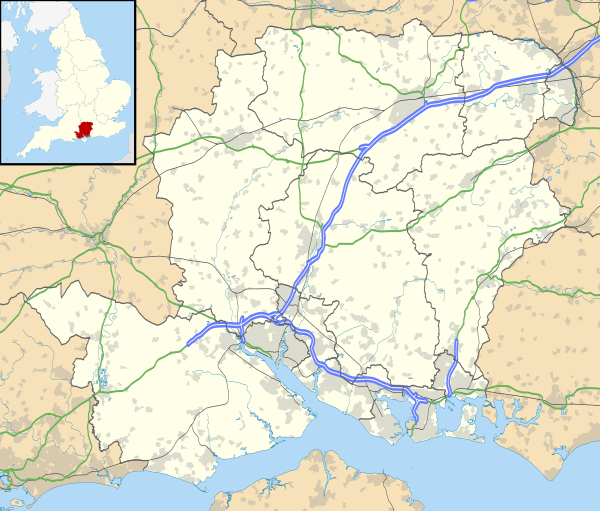Cambridge Barracks, Portsmouth
Cambridge Barracks was a military installation at Portsmouth, Hampshire.
| Cambridge Barracks | |
|---|---|
| Portsmouth | |
 Cambridge Barracks | |
 Cambridge Barracks Location within Hampshire | |
| Coordinates | 50.79204°N 1.09975°W |
| Type | Barracks |
| Site history | |
| Built | 1856–1859 |
| Built for | War Office |
| In use | 1859-1991 |
History
The barracks were created by converting some late-18th century warehouses into military accommodation in 1825.[1] The site had previously been a large timber-yard and carpenters' workshops; it was purchased by the government during the Napoleonic Wars and converted into an 'immense' stores complex for the Commissariat (responsible for supplying food, fuel and forage to the troops).[2] These former warehouses are still in place, forming an asymmetrical open courtyard at the south-west end of what is now Portsmouth Grammar School: they stand three storeys high and originally contained open-plan store rooms accessed through external hoist doors on each storey.[1] In October 1825 each floor was converted to form barrack rooms; the 9th Regiment (Fusileers) was the first to occupy the new barracks.[3] At that time a guard-house formed the fourth side of the quadrangle.[2]
In 1856-58 the barracks were extended and enhanced to create accommodation for regiments in transit for operations overseas. An officers' quarters was built, fronting on to the High Street, with a large officers' mess on the first floor.[4] At some distance behind it (so as to form a sizeable parade ground) a long, three-storey soldiers' barracks was erected, containing a series of back-to-back barrack rooms either side of a central office section, with a cook-house at the south-west end linking it to the older barrack blocks.[5] It was at around this time that the barracks were named after Prince Adolphus, Duke of Cambridge who had recently died.[6] Subsequently a two-storey block was built, between the old barracks quadrangle and the new officers' quarters, containing offices for the Commanding Officer and others.[1]
In January 1887 there was a serious gas explosion at the site in which five members of the Worcestershire Regiment died and fourteen were injured.[7][8] The 1st Battalion, the Northumberland Fusiliers was in transit at the barracks when the First World War broke out in August 1914.[9]
The barracks became disused and fell derelict after the First World War.[7] The officers' quarters were acquired by Portsmouth Grammar School in 1926.[10] The soldiers' barracks blocks were initially amalgamated into the adjacent Clarence Barracks; later, they too were acquired by the school, which now covers the entire former barracks site.[1] The school library occupies the former officers' mess.[4]
References
- Historic England. "Outbuildings to South West of Portsmouth Grammar School (1333200)". National Heritage List for England. Retrieved 17 September 2017.
- Slight, Henry; Slight, Julian (1828). Chronicles of Portsmouth. London: Lupton Relfe. p. 61.
- [according to Slight & Slight in 1828 - perhaps 7th (Fusilier) Regiment?]
- Historic England. "Portsmouth Grammar School and attached railings (1333199)". National Heritage List for England. Retrieved 17 September 2017.
- Historic England. "Former barracks to rear of Portsmouth Grammar School (1104363)". National Heritage List for England. Retrieved 14 August 2019.
- "Cambridge Barracks". Retrieved 17 September 2017.
- Groombridge, Garth (2017). "Portsmouth in 50 Buildings". Amberley Publishing. ISBN 978-1445664064.
- "Explosion of gas at Cambridge Barracks, Portsmouth (1887)". Worcestershire Regiment. Retrieved 17 September 2017.
- "First Alnwick man to fall in the war". Northumberland Gazette. 7 June 2014. Archived from the original on 17 September 2017. Retrieved 17 September 2017.
- "Derelict barracks was sold to become leading school". Portsmouth. 13 November 2012. Retrieved 17 September 2017.
Further reading
- Smith, Catherine (2001). A History of Cambridge Barracks.